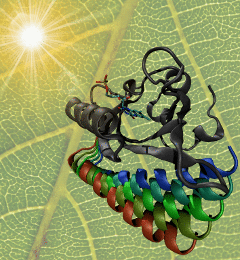Research Projects - Quantum Biology
Many important biological processes taking place in cells are driven and controlled by events that involve electronic degrees of freedom and, therefore, require a quantum mechanical description. An important example are enzymatically catalyzed, cellular biochemical reactions. Here, bond breaking and bond formation events are intimately tied to changes in the electronic degrees of freedom. Key events during photosynthesis in plants and energy metabolism in eucaryotes also warrant a quantum mechanical description - from the absorption of light in the form of photons by the photosynthetic apparatus to electron transfer processes sustaining the electrochemical membrane potential. Because of the importance of sensing light to both plants (for regulating vital functions) and animals (for vision), the interaction between light and biological photoreceptors is widespread in nature, and also requires a quantum mechanical description. A prime example is the protein rhodopsin which is present in the retina of the human eye and plays a key role in vision. Our computational tool are combined quantum mechanical/molecular (QM/MM) simulations, that allow to combine an electronic level description of the active region with a classical model of the environment provided by the remainder of the biomolecular system and solvent. This allows us to study the electronic level processes underlying these systems in their natural cellular environment.

image size:
1.9MB
made with VMD
Papers
From atomistic modeling to excitation transfer and two-dimensional spectra of the FMO light-harvesting complex. Carsten Olbrich, Thomas L. C. Jansen, Jörg Liebers, Mortaza Aghtar, Johan Strümpfer, Klaus Schulten, Jasper Knoester, and Ulrich Kleinekathoefer. Journal of Physical Chemistry B, 115(26):8609-8621, 2011.
Quest for spatially correlated fluctuations in the FMO light-harvesting complex. Carsten Olbrich, Johan Strümpfer, Klaus Schulten, and Ulrich Kleinekathoefer. Journal of Physical Chemistry B, 115:758-764, 2011.
Förster energy transfer theory as reflected in the structures of photosynthetic light harvesting systems. Melih Sener, Johan Strümpfer, Jen Hsin, Danielle Chandler, Simon Scheuring, C. Neil Hunter, and Klaus Schulten. ChemPhysChem, 12:518-531, 2011.
The effect of correlated bath fluctuations on exciton transfer. Johan Strümpfer and Klaus Schulten. Journal of Chemical Physics, 134:095102, 2011. (9 pages).
Energy transfer dynamics in an RC-LH1-PufX tubular photosynthetic membrane. Jen Hsin, Johan Strümpfer, Melih Sener, Pu Qian, C. Neil Hunter, and Klaus Schulten. New Journal of Physics, 12:085005, 2010. (19 pages).
Photosynthetic vesicle architecture and constraints on efficient energy harvesting. Melih Sener, Johan Strumpfer, John A. Timney, Arvi Freiberg, C. Neil Hunter, and Klaus Schulten. Biophysical Journal, 99:67-75, 2010.
Structural model and excitonic properties of the dimeric RC-LH1-PufX complex from Rhodobacter sphaeroides. Melih K. Sener, Jen Hsin, Leonardo G. Trabuco, Elizabeth Villa, Pu Qian, C. Neil Hunter, and Klaus Schulten. Chemical Physics, 357:188-197, 2009.
Light harvesting complex II B850 excitation dynamics. Johan Strümpfer and Klaus Schulten. Journal of Chemical Physics, 131:225101, 2009. (9 pages).
From atomic-level structure to supramolecular organization in the photosynthetic unit of purple bacteria. Melih K. Sener and Klaus Schulten. In C. Neil Hunter, Fevzi Daldal, Marion C. Thurnauer, and J. Thomas Beatty, editors, The Purple Phototrophic Bacteria, volume 28 of Advances in Photosynthesis and Respiration, pp. 275-294. Springer, 2008.
Atomic level structural and functional model of a bacterial photosynthetic membrane vesicle. Melih K. Sener, John D. Olsen, C. Neil Hunter, and Klaus Schulten. Proceedings of the National Academy of Sciences, USA, 104:15723-15728, 2007.
Comparison of the light harvesting networks of plant and cyanobacterial photosystem I. Melih K. Sener, Craig Jolley, Adam Ben-Shem, Petra Fromme, Nathan Nelson, Roberta Croce, and Klaus Schulten. Biophysical Journal, 89:1630-1642, 2005.
When light falls in LOV: A quantum mechanical/molecular mechanical study of photoexcitation in Phot-LOV1 of Chlamydomonas reinhardtii. Markus Dittrich, Peter L. Freddolino, and Klaus Schulten. Journal of Physical Chemistry B, 109:13006-13013, 2005.
ATP hydrolysis in the βTP and βDP catalytic sites of F1-ATPase. Markus Dittrich, Shigehiko Hayashi, and Klaus Schulten. Biophysical Journal, 87:2954-2967, 2004.
Role of hydrogen-bond network in energy storage of bacteriorhodopsin's light-driven proton pump revealed by ab initio normal mode analysis. Shigehiko Hayashi, Emad Tajkhorshid, Hideki Kandori, and Klaus Schulten. Journal of the American Chemical Society, 126:10516-10517, 2004.
Molecular dynamics simulation of bacteriorhodopsin's photoisomerization using ab initio forces for the excited chromophore. Shigehiko Hayashi, Emad Tajkhorshid, and Klaus Schulten. Biophysical Journal, 85:1440-1449, 2003.
A general random matrix approach to account for the effect of static disorder on the spectral properties of light harvesting systems. Melih Sener and Klaus Schulten. Physical Review E, 65:031916, 2002. (12 pages).
Structural determinants of spectral tuning in retinal proteins - bacteriorhodopsin vs sensory rhodopsin II. Shigehiko Hayashi, Emad Tajkhorshid, Eva Pebay-Peyroula, Antoine Royant, Ehud M. Landau, Javier Navarro, and Klaus Schulten. Journal of Physical Chemistry B, 105:10124-10131, 2001.
Kinetics of excitation migration and trapping in the photosynthetic unit of purple bacteria. Thorsten Ritz, Sanghyun Park, and Klaus Schulten. Journal of Physical Chemistry B, 105:8259-8267, 2001.
A model for photoreceptor-based magnetoreception in birds. Thorsten Ritz, Salih Adem, and Klaus Schulten. Biophysical Journal, 78:707-718, 2000.
Research Projects
- ATP Hydrolysis in F1-ATPase
- Organization of Energy Transfer Networks in Photosynthesis
- Light Harvesting by Carotenoids
- Biological Photoreceptors
- Spectral Tuning of Photoreceptors
- Quantum Dynamics of Photoreceptors
- Cryptochromes and Magnetic Sensing
- Molecular Motor Scooting along DNA
- Quantum Biology of Photosynthesis
- Eyes of Plants
- Excitation Dynamics
- Vibrationally Assisted Olfaction
- FMO Excitation Dynamics
- Atomic Level Structure and Function of a Photosynthetic Vesicle
- PHI - Parallel Hierarchy Integrator



